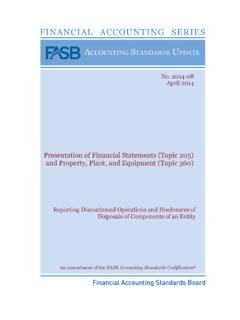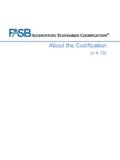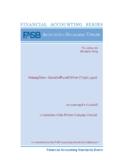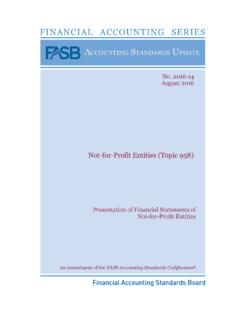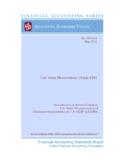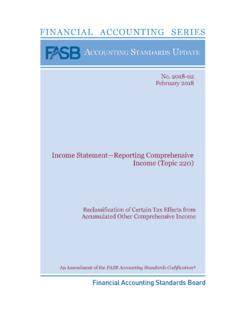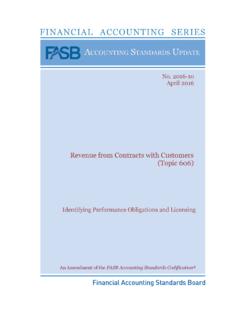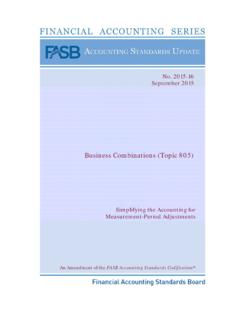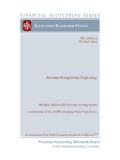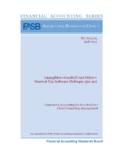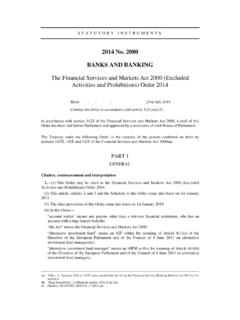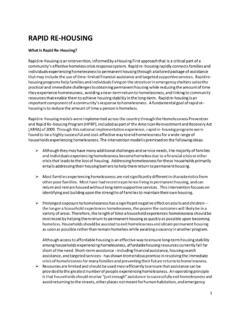Transcription of ASU 6x9 Final Template - asc.fasb.org
1 Revenue from Contracts with Customers (Topic 606) No. 2014 -09 May 2014 An Amendment of the FASB Accounting Standards Codification The FASB Accounting Standards Codification is the source of authoritative generally accepted accounting principles (GAAP) recognized by the FASB to be applied by nongovernmental entities. An Accounting Standards Update is not authoritative; rather, it is a document that communicates how the Accounting Standards Codification is being amended. It also provides other information to help a user of GAAP understand how and why GAAP is changing and when the changes will be effective. For additional copies of this Accounting Standards Update and information on applicable prices and discount rates contact: Order Department financial Accounting Standards Board 401 Merritt 7 PO Box 5116 Norwalk, CT 06856-5116 Please ask for our Product Code No.
2 ASU2014-09. financial ACCOUNTING SERIES (ISSN 0885-9051) is published quarterly by the financial Accounting Foundation. Periodicals postage paid at Norwalk, CT and at additional mailing offices. The full subscription rate is $242 per year. POSTMASTER: Send address changes to financial Accounting Standards Board, 401 Merritt 7, PO Box 5116, Norwalk, CT 06856-5116. | No. 398 Copyright 2014 by financial Accounting Foundation. All rights reserved. Content copyrighted by financial Accounting Foundation may not be reproduced, stored in a retrieval system, or transmitted, in any form or by any means, electronic, mechanical, photocopying, recording, or otherwise, without the prior written permission of the financial Accounting Foundation.
3 financial Accounting Foundation claims no copyright in any portion hereof that constitutes a work of the United States Government. An Amendment of the FASB Accounting Standards Codification No. 2014 -09 May 2014 Revenue from Contracts with Customers (Topic 606) financial Accounting Standards Board Accounting Standards Update Accounting Standards Update 2014 -09 Revenue from Contracts with Customers (Topic 606) May 2014 CONTENTS Page Numbers Summary .. 1 11 Amendments to the FASB Accounting Standards Codification .. 13 512 Section A Revenue from Contracts with Customers: Amendments to the Accounting Standards Codification .. 14 150 Section B Conforming Amendments Related to Revenue from Contracts with Customers: Amendments to the Accounting Standards Codification.
4 151 441 Background Information and Basis for Conclusions .. 513 699 Appendix: Comparison of Topic 606 and IFRS 15 .. 671 699 Amendments to the XBRL Taxonomy .. 700 1 Summary Why Is the FASB Issuing This Accounting Standards Update (Update)? Revenue is an important number to users of financial statements in assessing an entity s financial performance and position. However, previous revenue recognition requirements in generally accepted accounting principles (GAAP) differ from those in International financial Reporting Standards (IFRS), and both sets of requirements were in need of improvement. Previous revenue recognition guidance in GAAP comprised broad revenue recognition concepts together with numerous revenue requirements for particular industries or transactions, which sometimes resulted in different accounting for economically similar transactions.
5 In contrast, IFRS provided limited guidance and, consequently, the two main revenue recognition standards, IAS 18, Revenue, and IAS 11, Construction Contracts, could be difficult to apply to complex transactions. Additionally, IAS 18 provides limited guidance on important revenue topics such as accounting for multiple-element arrangements. Accordingly, the financial Accounting Standards Board (FASB) and the International Accounting Standards Board (IASB) initiated a joint project to clarify the principles for recognizing revenue and to develop a common revenue standard for GAAP and IFRS that would: 1.
6 Remove inconsistencies and weaknesses in revenue requirements. 2. Provide a more robust framework for addressing revenue issues. 3. Improve comparability of revenue recognition practices across entities, industries, jurisdictions, and capital markets. 4. Provide more useful information to users of financial statements through improved disclosure requirements. 5. Simplify the preparation of financial statements by reducing the number of requirements to which an entity must refer. To meet those objectives, the FASB is amending the FASB Accounting Standards Codification and creating a new Topic 606, Revenue from Contracts with Customers, and the IASB is issuing IFRS 15, Revenue from Contracts with Customers.
7 The issuance of these documents completes the joint effort by the FASB and the IASB to meet those objectives and improve financial reporting by creating common revenue recognition guidance for GAAP and IFRS. Who Is Affected by the Amendments in This Update? The guidance in this Update affects any entity that either enters into contracts with customers to transfer goods or services or enters into contracts for the 2 transfer of nonfinancial assets unless those contracts are within the scope of other standards (for example, insurance contracts or lease contracts). The guidance in this Update supersedes the revenue recognition requirements in Topic 605, Revenue Recognition, and most industry-specific guidance throughout the Industry Topics of the Codification.
8 Additionally, this Update supersedes some cost guidance included in Subtopic 605-35, Revenue Recognition Construction-Type and Production-Type Contracts. In addition, the existing requirements for the recognition of a gain or loss on the transfer of nonfinancial assets that are not in a contract with a customer (for example, assets within the scope of Topic 360, Property, Plant, and Equipment, and intangible assets within the scope of Topic 350, Intangibles Goodwill and Other) are amended to be consistent with the guidance on recognition and measurement (including the constraint on revenue) in this Update. What Are the Main Provisions?
9 The core principle of the guidance is that an entity should recognize revenue to depict the transfer of promised goods or services to customers in an amount that reflects the consideration to which the entity expects to be entitled in exchange for those goods or services. To achieve that core principle, an entity should apply the following steps: Step 1: Identify the contract(s) with a customer. Step 2: Identify the performance obligations in the contract. Step 3: Determine the transaction price. Step 4: Allocate the transaction price to the performance obligations in the contract. Step 5: Recognize revenue when (or as) the entity satisfies a performance obligation.
10 Step 1: Identify the Contract with a Customer A contract is an agreement between two or more parties that creates enforceable rights and obligations. An entity should apply the requirements to each contract that meets the following criteria: 1. Approval and commitment of the parties 2. Identification of the rights of the parties 3. Identification of the payment terms 4. The contract has commercial substance 5. It is probable that the entity will collect the consideration to which it will be entitled in exchange for the goods or services that will be transferred to the customer. 3 In some cases, an entity should combine contracts and account for them as one contract.
